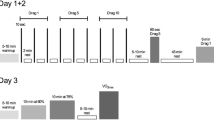Summary
Five elite speed skaters and fourteen well trained skaters of a lower performance level performed three maximal tests: a 3,000 m race from which the skating position and the stroke frequency were derived, an oxygen consumption test both during skating and during a bicycle ergometer test. From all subjects anthropometric measures were taken. The elite group showed a \(\dot V\)o2 during cycling of 64.4±3.5 ml·kg−1·min−1 and 59.4±3.7 ml·kg−1·min−1 during skating. The elite skaters showed: a shorter upper leg length with respect to total leg length, higher aerobic power during cycling, higher stroke frequency, smaller pre-extension knee angle coupled to higher work per stroke, higher “efficiency” during skating and higher external power during skating and during cycling when compared with the group of lower performance level.
It is concluded that an important pre-requisite for speed skating appears to be the possibility to skate at a small pre-extension knee angle without an excessive claim to anaerobic metabolism.
Similar content being viewed by others
References
Asmussen E, Bonde Petersen F (1974) Apparent efficiency and storage of elastic energy in human muscles during exercise. Acta Physiol Scand 29: 537–545
åstrand PO, Rodahl K (1977) Textbook of work physiology. McGraw-Hill, New York
åstrand PO, Saltin B (1961) Oxygen uptake during the first minutes of heavy muscular exercise. J Appl Physiol 16: 971–976
Bergh U, Thorstenssen A, Sjödin B, Hulten B, Piehl K, Karlsson J (1978) Maximal oxygen uptake and muscle fiber types in trained and untrained humans. Med Sci Sports 10: 151–154
Burke ER, Cerny F, Costill D, Fink W (1976) Characteristics of skeletal muscle in competitive cyclists. Med Sci Sports 8: 66
Charbonnier JP, Lacour J, Riffat J, Flandrois R (1975) Experimental study of the performance of competition swimmers. Eur J Appl Physiol 34: 157–167
Costill DL, Daniels J, Evans W, Fink W, Krahenbuhl G, Saltin B (1976) Skeletal muscle enzymes and fiber composition in male and female track athletes. J Appl Physiol 40: 149–154
Di Prampero PE, Cortili G, Celentano F, Cerretelli O (1971) Physiological aspects of rowing. J Appl Physiol 31: 853–857
Ekblom B, Hermansen L, Saltin B (1967) Hastighetsåkning på skrisko. Idrottsfysiology, nr. 5, Trygg-Hansa, Stockholm
Edwards RHT, Hill DK, McDonnel M (1972) Myothermal and intramuscular pressure measurements during isometric contractions of the human quadriceps muscle. J Physiol 224: 58P-59P
Farrel PA, Maksud MG, Pollock ML, Foster C, Anholm J, Hare J, Leon AS (1982) A comparison of plasma cholesterol, triglicerides and high density lipoprotein-cholesterol in speed skaters, weight-lifters and non-athletes. Eur J Appl Physiol 48: 77–82
Farrel PA, Wilmore JH, Coyle EF, Billing JE, Costill DL (1979) Plasma lactate accumulation and distance running performance. Med Sci Sports 11: 338–344
HermansenL, Ekblom B, Saltin B (1970) Cardiac output during submaximal and maximal treadmill and bicycle exercise. J Appl Physiol 29: 82–86
Igner F, Dahl H (1979) Dropouts from an endurance trainingprogram. Scand J Sports Sci 1: 20–22
Ingen Schenau GJ van, Bakker K (1980) A biomechanical model of speed skating. J Human Movement Stud 6: 1–18
Ingen Schenau GJ van (1982) The influence of air friction in speed skating. J Biomech 15: 449–458
Ingen Schenau GJ van (1981) A power balance applied to speed skating. Thesis, Free University, Amsterdam
Ivanov EB (1978) Morfologitsiskaia karakteristika konkobejtsev. Konkobejnii Sport 50–52
Ivanov VC, Vasilkovskii BM, Panov GM (1977) Materiali k izutseniiu spetzialnoi prenirovanosti konkobejtzev. Konkobejnii Sport 36–39
Ivanov VC, Orlov KA, Vasilkovskii BM, Schnaider VH (1979) Osobennosti funkzionalnoi adaptatzii v skorstnom bege na konkah. Konkobejnii Sport 35–37
Jackson RC, Secher NH (1976) The aerobic demands of rowing in two olympic rowers. Med Sci Sports 9: 168–170
Magel JR, Foglia GF, McArdle WD, Gutin B, Pechar GS, Katch FI (1975) Specificity of swim training on maximum oxygen uptake. J Appl Physiol 38: 151–155
Maksud MG, Wiley RL, Hamilton LH, Lockar B (1970) Maximal \(\dot V_{o_2 }\), ventilation, and heart rate of olympic speed skating candidates. J Appl Physiol 29: 186–190
Matsui H, Kitamura K, Miyamura M (1978) Oxygen uptake and bloodflow of the lower limb in maximal treadmill and bicycle exercise. Eur J Appl Physiol 40: 57–62
McArdle WD, Magel JR, Delio DJ, Toner M, Chase JM (1978) Specificity of run training on \(\dot V_{o_2 }\)-max and heart rate changes during running and swimming. Med Sci Sports 10: 16–20
McKay GA, Banister EW (1976) A comparison of maximal oxygen uptake determination by bicycle ergometry at various pedalling frequencies and by treadmill running at various speeds. Eur J Appl Physiol 35: 191–200
Miles DS, Critz JB, Knowlton RG (1980) Cardiovascular, metabolic and ventilatory responses of women to equivalent cycle ergometer and treadmill exercise. Med Sci Sports 12: 14–19
Petrofsky JS, Rochelle RR, Rinehart JS, Burse RL, Lind AP (1975) The assessment of the static component in rhythmic exercise. Eur J Appl Physiol 34: 56–63
Saltin B, Nazal K, Costill DL, Stein E, Jansson E, Essen B, Gollnick PD (1976) The nature of the training response, Peripheral and central adaptions to one-legged exercise. Acta Physiol Scand 96: 289–305
Wasserman K, Whipp BJ, Koyal SN, Beaver WL (1973) Anaerobic threshold and respiratory gas exchange during exercise. J Appl Physiol 35: 236–243
Weiner JS, Lomie JA (1969) Human biology, a guide to field methods. Blackwell, Oxford
Author information
Authors and Affiliations
Rights and permissions
About this article
Cite this article
van Ingen Schenau, G.J., de Groot, G. & Hollander, A.P. Some technical, physiological and anthropometrical aspects of speed skating. Europ. J. Appl. Physiol. 50, 343–354 (1983). https://doi.org/10.1007/BF00423240
Accepted:
Issue Date:
DOI: https://doi.org/10.1007/BF00423240




